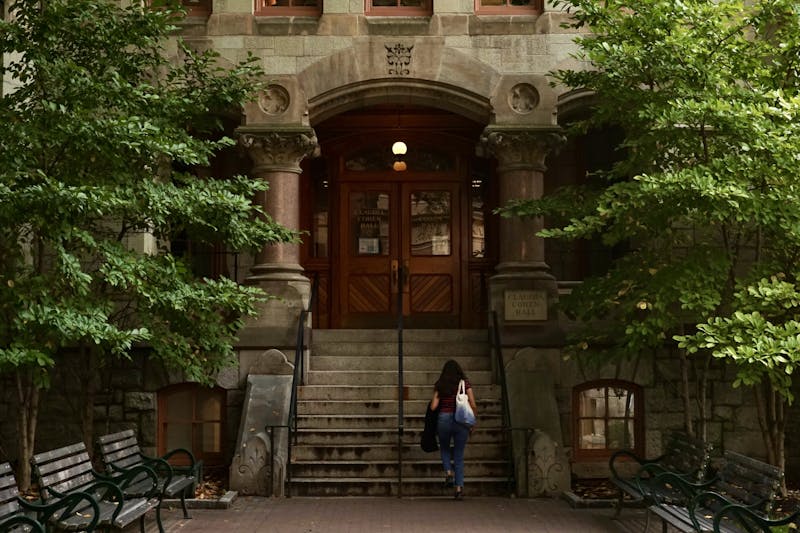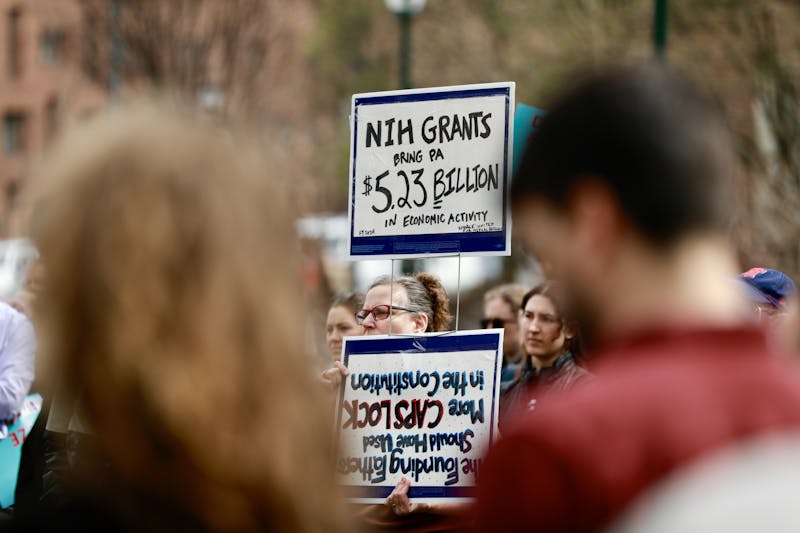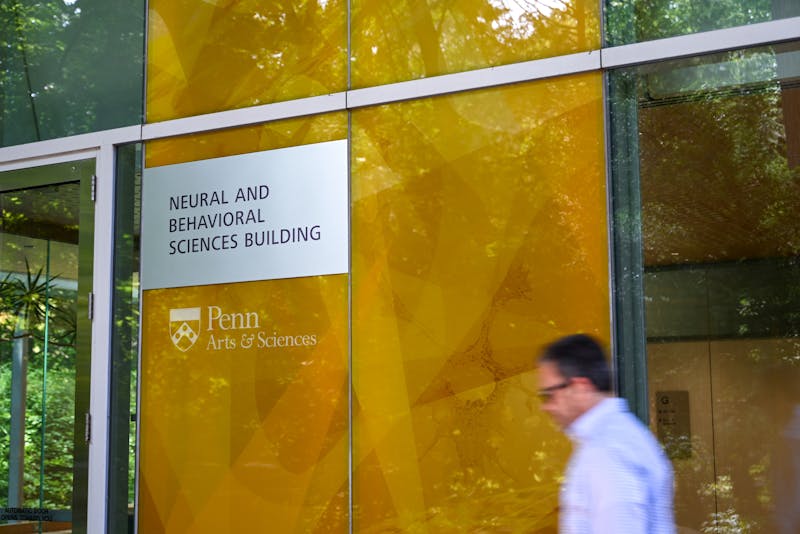
Students may not be happy about it, but universities can point to concrete costs to show why tuition increases happen. What’s less clear is how schools as diverse as Dartmouth and Harvard can regularly increase tuition at approximately the same rate.
Credit: Arabella UhryPenn’s cost of attendance increased by 3.9 percent this year; that’s in line with the rest of the Ivies, which all saw their sticker prices increase within an incredibly thin margin — Brown University, Cornell University, Harvard University and Yale University all increased their tuition between 3.5 and 4 percent for the 2017-18 year.
Other elite schools also saw similar tuition hikes: The University of Chicago increased its cost of attendance by 2.5 percent and Stanford University went up by 3.6 percent. In terms of absolute figures, the numbers have a fairly narrow spread — the cheapest Ivy to attend, based on tuition and fees, will be Princeton University at $48,550, while the most expensive will likely be Columbia University, which had its tuition and fees set at $55,056 for the 2016-17 year.
While this trend in college costs may not raise many eyebrows, such a uniform set of price increases in any other sector would point to one issue: price fixing. And although experts agree that a similar increase in tuition across elite college does not technically fall under this legal issue, the collaboration and relatively consistent sticker prices across these institutions would attract attention in other industries.
But there are many explanations for steep increases in tuition across schools. For one thing, not all tuition raised goes to the university. Financial aid expert Mark Kantrowitz, who has been featured in newspapers such as The New York Times and the Wall Street Journal, said that colleges often transfer some of this added tuition into raising financial aid. Bonnie Gibson, vice president for budget and management analysis at Penn, also called higher education a “human-intensive operation” earlier this month, referencing how retaining faculty can be a costly undertaking.
Students may not be happy about it, but universities can point to concrete costs to show why tuition increases happen. What’s less clear is how schools as diverse as Dartmouth University – located in rural Hanover, N.H. with an endowment of $4.5 billion — and Harvard — located in Cambridge, Mass., with an endowment of $37.6 billion — can regularly increase tuition at approximately the same rate.
Price fixing is defined by the Federal Trade commission as “an agreement (written, verbal, or inferred from conduct) among competitors that raises, lowers, or stabilizers prices or competitive terms.” Not all simultaneous or similar price changes are examples of illegal price fixing — pricing for commodities like wheat or oil is almost always uniform, and price-matching is not considered illegal.
Public universities are sometimes exempt from such laws. In March, Inside Higher Ed reported on a federal appeals court that determined Edinboro University was an arm of the state acting in the public interest, and private antitrust concerns did not apply.
But this immunity isn’t universal. A document from the National Association of College and University Attorneys lists areas in higher education where antitrust issues could potentially arise, including student housing, jointly establishing admissions protocols and the sharing of information between peer-group institutions.
In 1991, the Justice Department brought a lawsuit against the Ivy League schools and the Massachusetts Institute of Technology for anti-competitive practices in tuition. While the schools did not acknowledge any price-fixing behavior, they signed a consent decree with the Attorney General in which they agreed to end their joint policy of offering only similar need-based aid and terminated their regular “overlap” meeting in which several prestigious colleges in the Northeast would meet to discuss students who had gotten into more than one institution in the group.
Since then, schools have changed their policies regarding the sharing of financial information. Penn's “Guidelines on Cooperative Exchanges of Certain University Information” say “University officials must not participate in one-on-one or round table discussions with representatives of other institutions about projected or anticipated levels of tuition,” and that officials can only reveal information about policies, budget assumptions or tuition after they have been made public.
In an email to The Daily Pennsylvanian, Gibson said the University “does not consult with our Ivy League peers about tuition, nor do we have any idea what their tuition increases will be when we set our rate of increase.”
But it’s unclear to what degree this policy plays out in practice. While overt discussion of policies is not permitted, schools do not seem to be entirely out of the loop on how their peers are doing.
“Colleges and universities routinely meet with each other to discuss common issues,” said Richard Vedder, director of the Center for College Affordability and Productivity and professor emeritus at the Ohio State University.
Vedder said that he didn’t know whether the Ivy League schools and similar schools “literally talk tuition fees when they got together and meet.”
“I know they come close,” he said. “I mean, they talk about how much will fees go up next year and so on — I’ve been at meetings where there have been discussions sort of broadly along those lines — but overt setting of tuition I doubt is going on today.”
This kind of closeness between competitors, however, might garner more regulatory attention in another industry, he said.
“If Ford and [General Motors] and Toyota and Chrysler and so forth worked together and had a meeting to talk about things of interest,” he said, “people would be yelling and screaming and saying that’s an overt violation of antitrust laws — but it does go on in higher education.”
Price competition is much less prominent in higher education; for example, schools like Stanford or Penn do not offer marketing strategies like limited sales on tuition. But there is an important aspect by which colleges can compete on price — through financial aid.
In response to the 1991 suit, Ivy League schools and MIT argued that colluding on financial aid offers was actually in the public interest, as similar tuition costs would make it easier for students to choose a school based on interest or personal fit rather than due to financial concerns. Competition using merit scholarships would also reduce the amount of financial aid money available to students from lower income brackets, they said.
Today, none of the Ivy League universities offer merit scholarships, as is the case with MIT and Stanford. Duke University and the University of Chicago, however, continue to do so.
It’s worth noting that the schools become less uniform if you look at net price, not sticker price. While the average net price of attending Penn increased from 2012-2015, the average net price of attending Princeton declined during the same time period.
But not all students receive financial aid, and the continued consistency within tuition increases at elite schools today is not all that different from in 1991, when The New York Times reported that “such collusion [had] been suspected for many years, because tuition increases for the Ivy League universities came in virtual lockstep.” At the time, the cost of attendance at most of them exceeded the high amount of $20,000 a year.
“The fact that [schools] all raised tuitions at roughly the same time and the same amount would itself not be proof of an antitrust conspiracy,” Penn Law professor Howard Langer said.
Langer, who has taught antitrust law at Penn Law since 2001, said “Tacit collusion is not usually illegal absent further evidence.”
In 1991, schools had been holding meetings specifically to plan similar aid levels and were fairly open about any collusion taking place, which isn’t the case today.
“Unless you can find the presidents of the Ivy League schools, or whoever is responsible for setting tuition, sitting down or emailing one another about tuition in a way that you could infer they had an agreement, it would be very hard to prove [an antitrust] case,” Langer said.
Vedder agreed that an explicit agreement among Ivy League schools to fix tuition increases isn’t likely.
“If there was [collusion] I would think some politician would seize upon this as a way to achieve notoriety or popularity and call for lawsuits or actions against the colleges,” he said. “And we haven’t seen that.”
The Daily Pennsylvanian is an independent, student-run newspaper. Please consider making a donation to support the coverage that shapes the University. Your generosity ensures a future of strong journalism at Penn.
Donate






